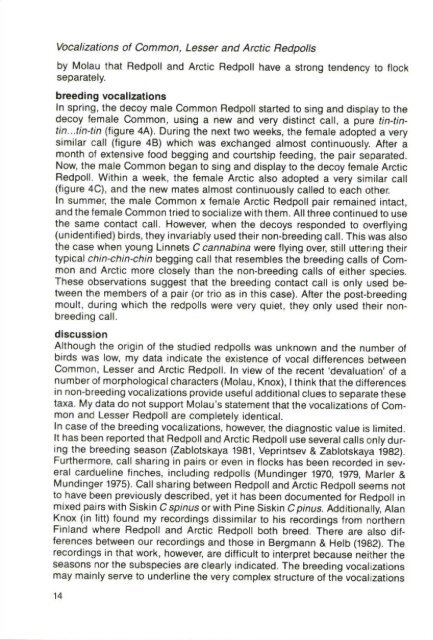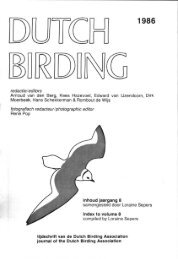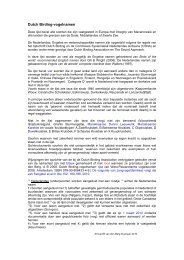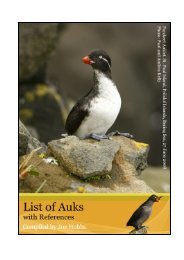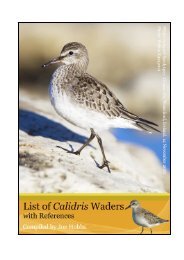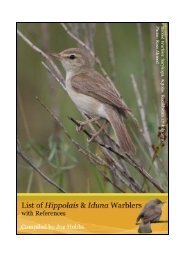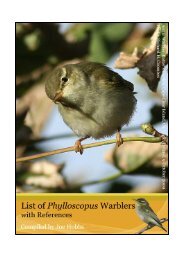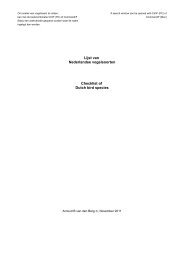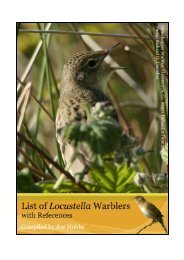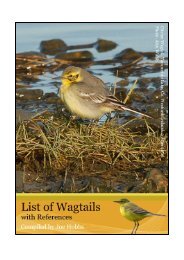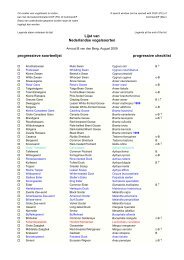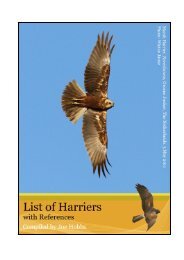You also want an ePaper? Increase the reach of your titles
YUMPU automatically turns print PDFs into web optimized ePapers that Google loves.
Vocalizations of Common, Lesser and Arctic Redpolls<br />
by Molau that Redpoll and Arctic Redpoll have a strong tendency to flock<br />
separately .<br />
breeding vocalization s<br />
In spring, the decoy male Common Redpoll started to sing and dispiay to the<br />
decoy female Common, using a new and very distinct call, a pure tin-tinfin<br />
. . .fin-trn (figure 4A) . During the next two weeks, the female adopted a very<br />
similar call (figure 4B) which was exchanged almost continuously. After a<br />
month of extensive food begging and courtship feeding, the pair separated .<br />
Now, the male Common began to sing and display to the decoy female Arctic<br />
Redpoll. Within a week, the female Arctic also adopted a very similar call<br />
(figure 4C), and the new mates almost continuously called to each other .<br />
In summer, the male Common x female Arctic Redpoll pair remained intact,<br />
and the female Common tried to socialize with them . Alt three continued to use<br />
the same contact call . However, when the decoys responded to overflying<br />
(unidentified) birds, they invariably used their non-breeding call . This was also<br />
the case when young Linnets C cannabina were flying over, still utterng their<br />
typical chin-chin-chin begging call that resembles the breeding calls of Common<br />
and Arctic more closely than the non-breeding calls of either species .<br />
These observations suggest that the breeding contact call is only used between<br />
the members of a pair (or trio as in this case) . After the post-breeding<br />
moult, during which the redpolls were very quiet, they only used their nonbreeding<br />
call .<br />
discussion<br />
Although the origin of the studied redpolts was unknown and the number of<br />
birds was low, my data indicate the existence of vocal differences between<br />
Common, Lesser and Arctic Redpoll . In view of the recent 'devaluation' of a<br />
number of morphological characters (Malau,l4nox), 1 think that the differences<br />
in non-breeding vocalizations provide useful additional clues to separate these<br />
taxa. My data do not support Molau's statement that the vocalizations of Common<br />
and Lesser Redpoll are completely identical .<br />
In case of the breeding vocalizations, however, the diagnostic value is limited .<br />
It has been reported that Redpoll and Arctic Redpoll use several calls only during<br />
the breeding season (Zablotskaya 1981, Veprintsev & Zablotskaya 1982) .<br />
Furthermore, call sharing in pairs or even in flocks has been recorded in several<br />
cardueline finches, including redpolls (Mundinger 1970, 1979, Marler &<br />
Mundinger 1975) . Call sharing between Redpoll and Arctic Redpoll seems not<br />
to have been previously described, yet it has been documented for Redpoll in<br />
mixed pairs with Siskin Cspinus or with Pine Siskin Cpinus . Additionally, Alan<br />
Knox (in litt) found my recordings dissimilar to his recordings from northern<br />
Finland where Redpoll and Arctic Redpoll both breed . There are also differences<br />
between our recordings and those in Bergmann & Helb (1982) . The<br />
recordings in that work, however, are difficult to interpret because neither the<br />
seasons nor the subspecies are clearly indicated . The breeding vocalizations<br />
may mainiy serve to underline the very complex structure of the vocalization s<br />
14


